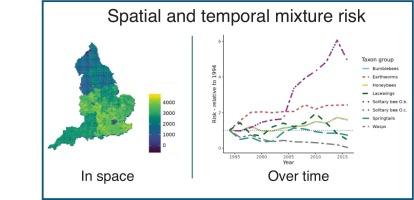Two decades of spatial and temporal pesticide risk to non-target invertebrates in England farmlands
IF 9.7
1区 环境科学与生态学
Q1 ENVIRONMENTAL SCIENCES
引用次数: 0
Abstract
Pesticide impact assessment methods provide relevant approaches to quantifying risks to non-target terrestrial biodiversity in agricultural systems. Here we develop such an approach through combined analysis of pesticide usage, cropping patterns and ecotoxicological hazard datasets to generate a temporal series of maps (1994–2016) of the spatial risk of pesticides for invertebrates in England. Using data for 179 insecticides, fungicides and herbicides applied on arable crops, we assessed how pesticide risk for bees, earthworms, springtails, parasitic wasps and lacewings varied in space and time over two decades of usage shift. Change in the extent of risk associated with annual applied pesticide amounts differed depending on the organism examined. Organophosphates, pyrethroids, organochlorines and neonicotinoids all contributed to risk in bees. Insecticides, fungicides and herbicides all contributed to risk in springtails. Unexpectedly herbicides (particularly chlorotoluran) had the largest contribution to risk in lacewings, albeit with some uncertainty. Insecticides (particularly organophosphates) made the greatest contribution to risk in parasitic wasps. For earthworms, fungicides (particularly triazole fungicides and the diarylamine fluazinam) were important for risk. A noteworthy finding was that temporal risks linked to pesticide usage have changed only modestly from 1994 to 2016, despite the changes in approved authorisations and key policy such as the removal from use of most members of the neonicotinoid class of insecticides. We discuss how insights, particularly those relating to the magnitude of risk, should be considered in future studies, and how the provision of higher resolution usage data and better hazard information could improve past and future pesticide risk understanding.

英国农田非目标无脊椎动物20年的时空农药风险分析
农药影响评估方法为量化农业系统中非目标陆地生物多样性的风险提供了相关途径。在这里,我们通过对农药使用、种植模式和生态毒理学危害数据集的综合分析,开发了这样一种方法,以生成英格兰无脊椎动物农药空间风险的时间序列地图(1994-2016)。利用179种用于耕地作物的杀虫剂、杀菌剂和除草剂的数据,我们评估了在20年的使用变化中,蜜蜂、蚯蚓、跳尾虫、寄生蜂和草蛉的农药风险在空间和时间上的变化。与每年施用农药量有关的风险程度的变化因所检查的生物体而异。有机磷、拟除虫菊酯、有机氯和新烟碱类都对蜜蜂造成风险。杀虫剂、杀菌剂和除草剂都增加了跳尾虫的风险。出乎意料的是,除草剂(尤其是氯脲)对草蛉的风险贡献最大,尽管存在一些不确定性。杀虫剂(特别是有机磷)对寄生蜂的危害最大。对蚯蚓来说,杀菌剂(尤其是三唑类杀菌剂和二芳胺类氟唑南)对风险有重要影响。一个值得注意的发现是,从1994年到2016年,尽管批准的授权和关键政策(如禁止使用大多数新烟碱类杀虫剂)发生了变化,但与农药使用相关的时间风险仅发生了轻微变化。我们讨论了在未来的研究中应该如何考虑见解,特别是那些与风险大小有关的见解,以及如何提供更高分辨率的使用数据和更好的危害信息来改善过去和未来的农药风险理解。
本文章由计算机程序翻译,如有差异,请以英文原文为准。
求助全文
约1分钟内获得全文
求助全文
来源期刊

Environment International
环境科学-环境科学
CiteScore
21.90
自引率
3.40%
发文量
734
审稿时长
2.8 months
期刊介绍:
Environmental Health publishes manuscripts focusing on critical aspects of environmental and occupational medicine, including studies in toxicology and epidemiology, to illuminate the human health implications of exposure to environmental hazards. The journal adopts an open-access model and practices open peer review.
It caters to scientists and practitioners across all environmental science domains, directly or indirectly impacting human health and well-being. With a commitment to enhancing the prevention of environmentally-related health risks, Environmental Health serves as a public health journal for the community and scientists engaged in matters of public health significance concerning the environment.
 求助内容:
求助内容: 应助结果提醒方式:
应助结果提醒方式:


